
In recent years anime has become a staple with American audience. There were a few Japanese cartoons that aired throughout the 1960s (Astro Boy, Speed Racer, and Gigantor comes to mind), but it wasn’t until the early 1990s when it really took off with American children and adults alike.
So one could wonder how American cartoons fared in Japan. The answer is that many did air in that country, some more successful than others. This is especially the case for Hanna-Barbera cartoons, many of which aired in Japan.
With Hanna-Barbera cartoons airing in Japan, many sported new theme songs created by Japanese composers and singers. I found several on YouTube and I thought it would be fun to showcase some of the more notable ones.
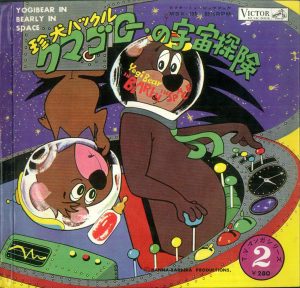 Yogi Bear
Yogi Bear
Japanese Title: Kuma Goro
Japanese Broadcast:
February 15, 1959-March 27, 1960 on NET (as part of “Huckleberry Hound”)
July 1, 1964-February 16, 1966 on NET (own series)
Like in the ‘States, Yogi Bear was first show as part of “Huckleberry Hound” when it got imported to Japan (known as “Chinken Huckle”, or “Fantastic Dog Huckleberry”) which aired from 1959 to 1964 on the NET network (now known as TV Asahi). Japan wouldn’t air Yogi’s own series until 1964, taking over Huck’s old time slot.
Yogi’s name was changed to Kuma Goro in Japan, but Boo-Boo and Ranger Smith retained their original names in the dub, although the latter was only referred to as “Smith-san” by others.
For the theme song, the music from the original was used under a different arrangement, with new lyrics to go along with it. Some of the Japanese intros for Hanna-Barbera shows had this happen, including Top Cat.
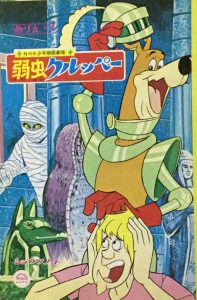 Scooby Doo, Where Are You?
Scooby Doo, Where Are You?
Japanese Title: Yowamushi Kuruppa (Cowardly Clooper)
Japanese Broadcast: February 1 to June 7, 1970 on NHK
“Scooby-Doo” is probably the most successful property to come out of Hanna-Barbera, with new materials still being produced more than 50 years after it first appeared on CBS Saturday Mornings. In Japan it wasn’t as successful, although it did get rerun over the years.
In Japan it first appeared in February 1, 1970 on NHK, where they ran the show as the second half of the hour-long “Boy’s Movie Theater” block. In this version the characters names were changed for the local audience:
Scooby-Doo = Clooper
Shaggy = Boropin
Fred = Handsome
Daphne = Jenny
Velma = Megako (lit. “Glasses Girl”)
The new theme song is very different from the original intro, where it roasts Scooby (Clooper) for being a coward, singing about how everybody ridicules him. The intro was sung by a band Red Stone. The choice of clips for the intro is unusual, in that it focuses strictly on Scooby and Shaggy (although you can see Fred for one frame), with very little emphasis on spooky ghosts, making it seem like the show is just them eating food and being scared.
In recent years, whenever anything Scooby-Doo is shown in Japan they revert to the original US names for the characters. However, when Cartoon Network’s Japanese station reran the original “Where Are You?” with brand-new dubs, they retained the title and names from the NHK dub, even using the theme song, although this time it was played over the footage from the original intro.
Jonny Quest
Japanese Title: Kagaku Shonen J.Q. (“Scientific Boy J.Q.”)
Japanese Broadcast: January 29-September 24, 1965 on TBS
The characters retained their names in the Japanese dub, although Jonny himself was usually referred to by his initials J.Q.
The song is notable in that it was sung by Kyu Sakamoto, who had the distinction of being one of the very few Japanese singers to have a sit single in the US for “I Look Up As I Walk”, known to Americans as “Sukiyaki”, which topped the Billboard charts in 1963.
As a bonus, here’s an audio drama for Jonny Quest that was released during this time, complete with a manga to go along with the audio. Watch it here
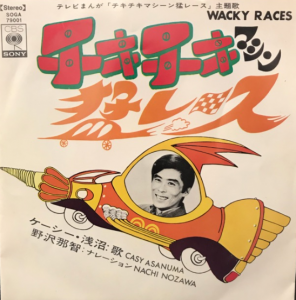 Wacky Races
Wacky Races
Japanese Title: Chikichiki Machine Mo-Race
Japanese Broadcast: April 6-July 27, 1970 on NET
Name-wise, Dick Dastardly was renamed Black Mao (Black Devil), with Muttley as Ken-Ken (referring the snickering sound he would make), with the Mean Machine known as “Zero Zero Machine”. Other characters had their names changed as well, including Penelope Pitstop, who was called “Milk-chan”; however, when the spin-off “The Perils of Penelope Pitstop” aired in Japan the same year they reverted back to her original name in the dub.
Of all the Hanna-Barbera shows that was imported to Japan, the one that became a cult favorite is “Wacky Races”. The series is fondly remembered in the country and is a common nostalgia fodder among older Japanese fans. It’s not unusual for anime to reference or parody this show, most recently “Pop Team Epic”.
In 2006, TV Asahi made a list of Top 100 Animated Programs by interviewing celebrities, and “Wacky Races” had the distinction of being one of only two non-Japanese cartoons to make the list (the other was “Tom and Jerry”). Source: https://www.animenewsnetwork.com/news/2006-10-13/japans-favorite-tv-anime
Here is the Japanese intro. Main vocal by Casy Asanuma:
 The Perils of Penelope Pitstop
The Perils of Penelope Pitstop
Japanese Title: Penelope Zettaizetsumei (Penelope in Peril)
Japanese Broadcast: June 14, 1970-October 11, 1971 on NHK
Both “Wacky Races” spin-offs aired in Japan. “Dastardly and Muttley In Their Flying Machines” would take over the former “Races” timeslot on NET on August 1970, while “Penelope Pitstop” would air on NHK, taking over Scooby-Doo’s time slot on NHK.
Penelope was called Milk-chan in the “Wacky Races” dub, but she reverted back to her original name when this show was broadcast. The Hooded Claw was renamed “The Caped Bespectacled Phantom” in the dub.
After the show finished its run on NHK it was later rerun on Tokyo 12 Channel (now TV Tokyo) as part of the “Manga Country” block, which had numerous other Hanna-Barbera shows (and old anime) airing alongside.
Casy Asanuma was the main vocal in this theme song.
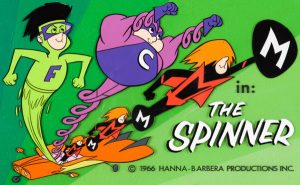 Frankenstein Jr. and the Impossibles
Frankenstein Jr. and the Impossibles
Japanese Title: Super Three (“The Impossibles”), Franken-Robo (“Frankenstein Jr.”)
Japanese Broadcast: September 8, 1967-January 5, 1968 on NET
The Impossibles (called “Super Three” in Japan) had a catchy theme song for the dubbing. While never a huge hit like “Wacky Races”, the show retains a cult following in Japan to this day.
The lyrics is credited to “Ichi Takami”, most likely a pseudonym. The singing was done by Keiroku Seki, Susumu Ishikawa, and Kinya Aikawa, who also voiced the characters in the dub (doing Coil Man, Fluid Man, and Multi Man respectively). Susumu Ishikawa has done voices for Japanese dubs of American cartoons (he also dubbed Secret Squirrel), but he’s primarily known for singing anime theme songs, having sang the opening song for “Q-Taro the Ghost”, “Umeboshi Denka”, and “The Gutsy Frog”.


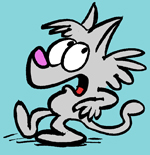 Charles Brubaker is a cartoonist originally from Japan. In addition to his work for MAD Magazine and SpongeBob Comics, he also created Ask a Cat for GoComics. You can also follow him on his Tumblr page.
Charles Brubaker is a cartoonist originally from Japan. In addition to his work for MAD Magazine and SpongeBob Comics, he also created Ask a Cat for GoComics. You can also follow him on his Tumblr page.











































Subarashii! I am fascinated by the ways in which Japanese cartoons are adapted for English-speaking audiences and vice versa. Shitsumon ga aru:
Is it correct that Velma’s name in Yowamushi Kuruppa is “Megako”? Every otaku knows that the Japanese word for a girl with glasses is “meganekko” (megane = glasses, ko = child/girl). Is “Megako” thus a truncation, and if so — given that “mega” means the same in Japanese as in English — is it also an ironic pun on the fact that she’s the smallest of the group? (The complexities of Japanese wordplay make my head spin.)
I’m sorry you weren’t able to include the Japanese theme song to “Dastardly and Muttley in Their Flying Machines”. I was wondering whether it had the same refrain of “Hato wo tomete” (Stop that pigeon!).
Any chance of putting some romaji subtitles on these videos? Sono uta ga totemo suki soshite manabitai desu!
Doumo arigatou gozaimasu, Brubaker-sensei.
Japanese “Dastardly and Muttley In Their Flying Machines” theme music is:
https://youtu.be/mdkLH9boFP0
Arigatou gozaimasu, Yoshi-san. Hato nashi — gakkarishita!
That is, I’m disappointed that the pigeon isn’t mentioned in the theme song. The Japanese title of the show is “Sky Kid Black”. I wonder if “Yankee Doodle Pigeon” translates as “Banzaibato”?
I never understood why Wacky Races, of all shows, made the Top 100 list in Japan. Tom & Jerry, I sorta understand- it doesn’t have much dialogue so it’s easy to have universal appeal, but what made Wacky Races so beloved in Japan, more than any of the other HB TV shows?
And this raises another question: Does the new show hold the same popularity in Japan? Because as far as I’m concerned, it’s way better than the original 1968 show.
I think it was because of Mr. Dastardly and Muttley and that race show were popular in Japan at the time (i.e. “Speed Racer”). I thought this was a good show. It was one of the last good show at H-B before the Parent Code flew in and darken their doorstep.
That picture of Wilma at the top of the column begs the question : How did THE FLINTSTONES fare in Japan, main title-wise?
I found this promotional slide for the Japanese broadcast on “The Flintstones” (it aired on Fuji TV 1961-67), but I couldn’t find the main title, alas. The Japanese title is VERY weird: it literally translates to “Strong Spouse Heaven”.
That is a peculiar title Charles! It’s almost like they watched a few episodes and came to the conclusion you had to be strong to live in the house Fred and Wilma do.
“Milk-chan”??? Is “milk” has some other meaning in Japanese or something?
Uh WELL IN JAPAN GLAMOUR REFERS TO WOMEN WITH LARGE BUST”
You indicate that they changed Yogi Bear’s name to Kuma Goro, but I don’t believe that’s accurate. They changed the name of the PROGRAM to Kuma Goro (roughly “Average Bear”), but Yogi was still Yogi. Not only does his name appear twice in the animated opening, but you can also hear “Yogi (something something) kuma goro” at the end of the song.
Interesting they titled the show “Average Bear” otherwise (but I guess it would work as a misnomer).
I checked. They really did call Yogi “Kuma Goro” in the old dub.
I think they eventually started calling him by his original name later on, though, like they did with Scooby-Doo.
Wacky Races was popular enough to get two Japanese-developed video games—one for the Famicom/NES, and one for the Game Boy. Atlus (Megami Tensei, Persona) published both games. While the former made it to North American shores, the latter stayed in Japan. Why do I bring this up? Well, the Famicom/NES game features a nice 8-bit redention of the “Chikichiki Machine Mou Race” intro…which the North American release retained!
It was nice Atlus didn’t remove it for our release.
https://www.youtube.com/watch?v=7RXoPTP2i1o
>Does “milk” have some other meaning in Japanese
Not according to Google translate. I guess it was a comment on her milky complexion – – or her American figure.
That’s probably what they were going for with the name.
Of course years later, we’d have “Super Milk-Chan” which was nothing like Wacky Races’ Penelope at all!
Miruku (“milk”) is a syllabic metathesis of Mikuru, which is an authentic Japanese girl’s name. So to Japanese ears, “Milk” sounds like a pretty, feminine name, albeit one of obviously foreign origin. It would be analogous if a Western cartoon of the sixties had had a Japanese character named “Sushi”, because it sounds like “Susie”.
As for the connection of the name with Miss Pitstop’s complexion and/or figure, that is highly probable. It is widely believed in Japan that Western women are more voluptuous because of the high dairy content in their diet, and this is often referenced in anime. For example, a bit in Azumanga Daioh has Tomo categorising her classmates by breast size, as either Japanese (small), American (large), or Hawaiian (intermediate). Of course the girls in question are all Japanese by nationality.
“Chan” is an affectionate diminutive suffix, often used when addressing children or sweethearts. It can be affronting when used by a foreigner, so it’s best to avoid it and to address everyone by the polite honorific “-san”.
I’d love to know what the Flintstones characters’ names were in the Japanese dub.
Great piece! You are doing the Lord’s work here!
The Japanese Tom & Jerry theme is nice, too :
https://www.youtube.com/watch?v=ztwfdKbAFIE
Here a few more HB Japanese titles:
-Sinbad Jr.: https://www.youtube.com/watch?v=NyNE-s3sGP0&list=RDNyNE-s3sGP0&index=1
-It’s the Wolf: https://www.youtube.com/watch?v=gwsTjBtLJR4&list=RDNyNE-s3sGP0&index=2
-The Herculoids: https://www.youtube.com/watch?v=K6pHynlUnaY&list=RDNyNE-s3sGP0&index=7
-Shazzan: https://www.youtube.com/watch?v=QaJnqi82o40&list=RDNyNE-s3sGP0&index=6
Another Japanese titles for american cartoons:
– KING KONG(Ranking /Bass): https://m.youtube.com/watch?v=eAWmRZZc1YA
– SPIDER MAN (1967 series by Grant/Ray/Lawrence): https://m.youtube.com/watch?v=yUkoWW707U0
– FANTASTIC FOUR(Hanna – Barbera’s 1967 series. Knowed in Japan as… UCHŪU NO NINJA=Space Ninjas): https://m.youtube.com/watch?v=gWDmQjLnAiQ
– BIRDMAN(knowed in Japan as U- BIRD): https://m.youtube.com/watch?v=SLb2dKp7VNc
-JOSIE AND THE PUSSYCATS: https://m.youtube.com/watch?v=IPCZCYjHPIQ
– GROVVIE GOOLIES(Filmation): https://m.youtube.com/watch?v=7vm__gmK7J4
– SPACE GHOST: https://m.youtube.com/watch?v=dVRmoP9rOzU
Oh, I forgot to mention these:
– GALAXY TRIO(Hanna – Barbera) : https://m.youtube.com/watch?v=W9VoM4If7U4
– THE MIGHTY HERCULES(Trans – Lux) : https://m.youtube.com/watch?v=yO9_QTnHqk4
– THE MIGHTY MIGHTOR : https://m.youtube.com/watch?v=Pqfq0DCuopo
Andd these:
– THE NEW ADVENTURES OF BATMAN(Filmation): https://m.youtube.com/watch?v=ItIXcpf6uhw
– X- MEN : https://m.youtube.com/watch?v=2rSw4Xl5qfs
– BATMAN : THE ANIMATED SERIES(1992) : https://m.youtube.com/watch?v=pUwjYmz-h9M
– SABRINA THE TEENAGE WITCH(Filmation): https://m.youtube.com/watch?v=kEHUzgDUbn8
– HONG KONG PHOOEY : https://m.youtube.com/watch?v=ah3zbYMczVE
And last, but not least, THIS!
Superman( 1966 Filmation series) : https://m.youtube.com/watch?v=n623dpO-n1s
These have started appearing on my YouTube recommendations recently so thanks for the additional info on them.